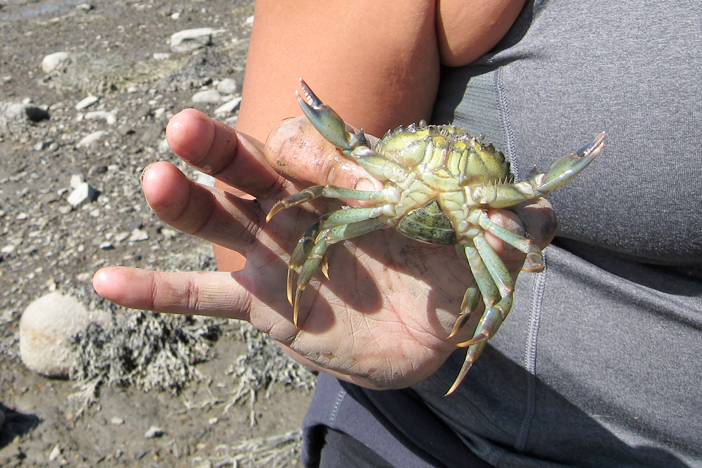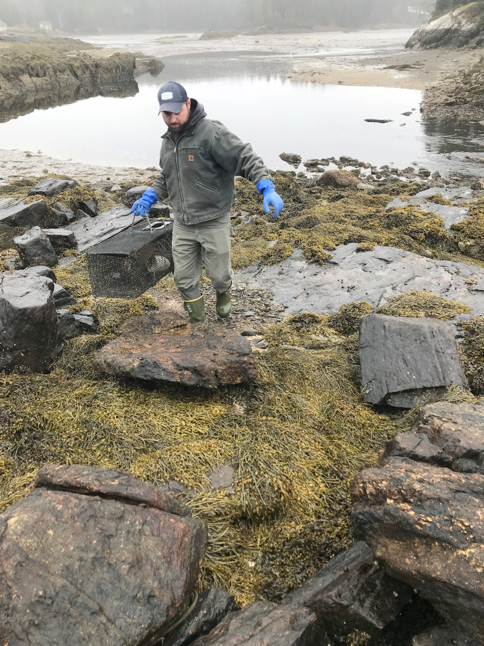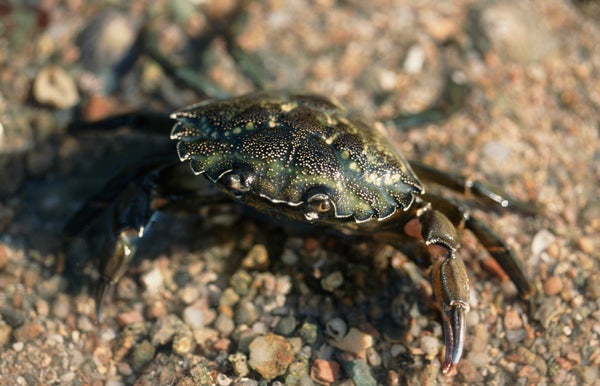On a rockymudflat nestled between a few islands off Portsmouth, N.H., Gabriela Bradt rustles a clump of seaweed and shifts her ear toward the ground. “Hear that?” she asks. The rasps of something scuttling emerge from underneath the mound. “There’s one,” she says, pointing to the mottled brownish-green back of a European green crab sidestepping across the matching mud.
She grabs the crab, jots down its size and color on her clipboard and drops it into a bucket with several others. Bradt, a fisheries specialist at the University of New Hampshire, is stockpiling these abundant (and aggressively invasive) crustaceans in an effort to study their biology—and to launch the country’s first green-crab soft-shell fishery.
It is one of many desperate attempts across North America to cull the species, which has steadily multiplied from Maryland to Nova Scotia and from California to southern British Columbia. With an appetite for more than 30 different plant and animal species, the crabs ravage commercial shellfisheries, destroy coastal seagrass beds and fundamentally shift ecosystems where they take hold. The Canadian Department of Fisheries and Oceans describes European green crabs as “one of the ten most unwanted species in the world,” and biologists have struggled to slow the animals’ spread with intermittent trapping and removal alone. Now, as New England waters warm and threaten to further boost populations, Bradt and her colleagues in Maine hope their soft-shell plan might weaken the crustaceans’ grip and bolster the local fishing industry at the same time.
On supporting science journalism
If you're enjoying this article, consider supporting our award-winning journalism by subscribing. By purchasing a subscription you are helping to ensure the future of impactful stories about the discoveries and ideas shaping our world today.
“The crabs will sell themselves,” says Bradt, whose team has already connected with 15 local chefs interested in serving them soft-shell. But before this treat can become a regular menu offering, she and her colleagues must unravel details about green crabs’ biology to pinpoint when to harvest them.

Gabriela Bradt holds a European green crab she caught during a routine survey nearby Portsmouth, N.H. She estimates she has processed more than 5,000 crabs just this year. Credit: Laura Poppick
An Invasive Delicacy
European green crabs are native to coastal waters from northern Africa to Norway and first arrived on the East Coast of North America in ship ballast and stuck to hulls in the early 1800s. A soft-shell market for closely related Mediterranean green crabs already exists in Venice, where they have been considered a delicacy for centuries.
The crabs have a rich, delicate flavor and can be fried and eaten whole in their soft-shell form, eliminating the tedious task of picking meat out of limbs, as with hard-shell crabs. Green crabs are too small to warrant this time-consuming effort, but the ease of serving them whole with a soft shell—legs, innards, claws and all—appeals to both chefs and diners.
This market, however, has never taken off in the U.S.—in part because it is difficult to determine when the crabs are about to molt, or shed their old shell, exposing the softness chefs seek. Researchers in New England only recently recognized the trove of knowledge Venetian fishers have about the crab’s life cycle, and this resource has proved key to helping get efforts off the ground with the slightly different European species.
The brief window for catching a soft-shell crab opens when the animal outgrows and discards its exoskeleton to expose its tender body, which begins to harden again within only about 24 hours. Whereas Atlantic blue crabs—more commonly caught in soft-shell form farther south in the U.S.—develop a distinctive, bright red rim right around their swimming legs before they shed their shell, green crabs do not conspicuously indicate when they are about to molt. “It’s a very tricky biological question,” says Emily Grason, a marine ecologist at Washington Sea Grant at the University of Washington, who is monitoring a much smaller but expanding green crab population within Washington State’s inland waters.
To untangle answers, Bradt and her collaborators in Maine have conducted field surveys and laboratory studies to document the seasonality, water temperature, salinity and morphological changes that coincide with molting. They have collected more than 10,000 crabs since 2016. Her colleague Marissa McMahan of Manomet, a nonprofit environmental science organization with an office in Brunswick, Maine, has also trained with Venetian fishers.
Through many hours of observations during and after this training, McMahan’s team now has a roughly 85 percent success rate in predicting molting in males. Segments of the crab’s underside begin to darken around the edges roughly three weeks before they molt, indicating that a new shell has started to form beneath the old one and that the two shells are beginning to separate. This “shadow line” progresses toward the centers of the shell segments as the crab nears its molt, McMahan explains. The researchers have already trained four fishers—two in Maine and two in Massachusetts—who have sold the animals to local restaurants at about $25 per pound, which is comparable to the price of blue crabs. This success shows that launching a fishery is “not an insurmountable thing,” McMahan says.
Premolt females have proved harder to discern because they have a broader abdomen and narrower segmented regions where shadow lines emerge. Venetian crabbers do not even bother harvesting them for that reason, McMahan says. But Bradt is continuing to study female patterns in hopes of making use of them and extending the soft-shell season into the early fall, when females molt (males tend to molt in the late spring).
Researchers elsewhere in Maine are exploring additional ways to monetize the crabs as dog food, fish sauce, fertilizer and other products that incorporate the entire animal, including its hard shell. But chefs are willing to pay around $3 each for full-grown soft-shell crabs, making that option the most lucrative, McMahan says. She hopes that, eventually, these different products might coexist so fishers can profit from catching the crustaceans at all life stages.

Green crabs can be baited and gathered in traps similar to lobster traps, but with smaller openings to contain the crabs' relatively small bodies. Credit: Marissa McMahan
Increasing Urgency
As interest in these crabs grows, so, too, does the urgency of getting them out of the water. They have been responsible for roughly $22.6 million in annual losses within East Coast shellfisheries, according to a study presented at the 2007 meeting of the Agricultural & Applied Economics Association. Between 2012 and 2013 they destroyed more than half of Casco Bay’s roughly 3,300 hectaresof eelgrass beds, which serve as an important fish nursery off the coast of southern Maine. “That was dramatic and astounding,” says Hilary Neckles, a U.S. Geological Survey ecologist who published a report on the event and attributes it to a surge in European green crab populations linked to record-breaking ocean warmth in 2012.
As ocean waters warm faster in the Gulf of Maine than almost anywhere else in the world, local conditions will continue to promote these population surges. Brian Beal, a biologist at the University of Maine at Machias who studies green crabs’ particularly severe damage to soft-shell clam fisheries, says these animals thrive in warmer waters. “They have higher predation rates” in warm conditions, he says. “They produce more offspring. They have higher survival rates.”
Beal does not think a soft-shell European green crab fishery will mitigate the crustaceans’ considerable damage to the clam fisheries: predation generally occurs when both the crabs and the clams they are eating are a millimeter or less in size, long before the crab is big enough to trap. But producing a market for them is one benign way to put them to use—and “they taste great,” he says.
If the fishery does take off as Bradt and McMahan hope, McMahan says it may eventually grow robust enough to dent the crab population. In the meantime, the researchers will continue working next year, when they will streamline their methods and train prospective crabbers to incorporate the species into the local economy. “The biggest thing is figuring out how to increase supply,” McMahan says. “We know that the demand is there.”
